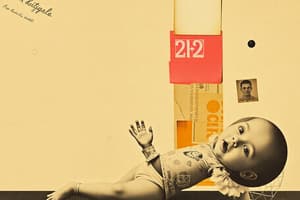Podcast
Questions and Answers
Which type of movements exist in absence of observable sensory stimuli?
Which type of movements exist in absence of observable sensory stimuli?
- Reflex movements
- Spontaneous movements (correct)
- Voluntary movements
- Protective movements
Which reflex involves the arms moving into abduction as a protective response?
Which reflex involves the arms moving into abduction as a protective response?
- Flexor withdrawal reflex
- Gag reflex
- Sucking and rooting reflex
- Moro reflex (correct)
What does the term 'head lag' refer to in the context of motor development?
What does the term 'head lag' refer to in the context of motor development?
- Inability to lift head in prone position
- Inability to balance on own while sitting (correct)
- Gravity pulling the head forward in sitting position
- Flexion in arms and legs remaining in neonate prone position
Which reflex protects the airways in response to a stimulus?
Which reflex protects the airways in response to a stimulus?
What is the role of specific reflexes in later voluntary movement?
What is the role of specific reflexes in later voluntary movement?
What do current research models reveal about infant motor development?
What do current research models reveal about infant motor development?
What does the term 'neonate' refer to in the context of motor development?
What does the term 'neonate' refer to in the context of motor development?
What does the term 'prone' refer to in the context of motor development?
What does the term 'prone' refer to in the context of motor development?
What does the term 'supine' refer to in the context of motor development?
What does the term 'supine' refer to in the context of motor development?
What does the term 'flexor withdrawal' refer to in the context of reflexes?
What does the term 'flexor withdrawal' refer to in the context of reflexes?
What is the primary sensory input for balance until the age of 3 years?
What is the primary sensory input for balance until the age of 3 years?
At what age do children reach adult levels of spontaneous sway with eyes open?
At what age do children reach adult levels of spontaneous sway with eyes open?
What is the approximate age range when children are particularly slow in reactive responses and sway for longer?
What is the approximate age range when children are particularly slow in reactive responses and sway for longer?
What is the primary risk factor for falls according to the text?
What is the primary risk factor for falls according to the text?
What characterizes the ability to interpret sensory information and apply it to postural actions?
What characterizes the ability to interpret sensory information and apply it to postural actions?
What is the approximate age range when the vestibular system matures with eyes closed?
What is the approximate age range when the vestibular system matures with eyes closed?
What system undergoes a period of transition until it reaches a new plateau of stability?
What system undergoes a period of transition until it reaches a new plateau of stability?
What influences the decrease in balance as one gets older?
What influences the decrease in balance as one gets older?
What is the primary input for balance after the age of 3 years?
What is the primary input for balance after the age of 3 years?
What is the approximate age range when children reach adult levels of spontaneous sway with eyes open?
What is the approximate age range when children reach adult levels of spontaneous sway with eyes open?
What is a key goal for infants aged 4-6 months in terms of postural control development?
What is a key goal for infants aged 4-6 months in terms of postural control development?
Which milestone should infants aged 7-9 months be able to demonstrate?
Which milestone should infants aged 7-9 months be able to demonstrate?
What is crucial for postural control in infants?
What is crucial for postural control in infants?
What influences the development of postural responses in infants?
What influences the development of postural responses in infants?
At what age should infants be able to squat to play with eccentric control of quadriceps and calf range?
At what age should infants be able to squat to play with eccentric control of quadriceps and calf range?
What is the last type of postural responses to develop in infants?
What is the last type of postural responses to develop in infants?
What influences the recruitment of postural adjustment or protective responses in infants?
What influences the recruitment of postural adjustment or protective responses in infants?
What do infants develop in their lower limbs when achieving standing?
What do infants develop in their lower limbs when achieving standing?
What is a key influence on postural control development in infants?
What is a key influence on postural control development in infants?
What is the second line of defense to protect the head from hitting the surface in infants?
What is the second line of defense to protect the head from hitting the surface in infants?
Flashcards are hidden until you start studying
Study Notes
Developmental Milestones in Infants' Postural Control
- Infants aged 4-6 months should achieve prone weight bearing on forearms with some strength against gravity and chin tuck, and they should be able to track objects with their eyes and bring hands and feet to the midline.
- Key goals for infants aged 4-6 months include eye-hand coordination and reaching and grasping toys, while those aged 9-15 months should develop fine pincer grasp and constructive play.
- Infants aged 6-8 months should progress to reaching forward from the base of support and sitting upright, and those aged 7-9 months may demonstrate commando crawling.
- Infants aged 9-15 months should be able to crawl on hands and knees, stand alone with a wide base of support and lumbar lordosis, and squat to play with eccentric control of quadriceps and calf range.
- Postural control development in infants is influenced by intact musculoskeletal system, proprioceptive, visual, and vestibular systems, and maturation and experience.
- There is a large variation in postural control development between females and males, and the process of mapping individual senses to actions, such as vision stimulating action in neck muscles for head righting, is crucial for postural control.
- Infants develop postural responses that are reactive (responding to perturbations) and anticipatory (preparing the body for movement or in anticipation of being perturbed).
- Adaptive postural responses are the last to develop in any particular orientation or posture, and protective responses, such as extension of limbs and movement away from the trunk, act as the second line of defense to protect the head from hitting the surface.
- Postural adjustment or protective response recruitment in infants is influenced by the speed and strength of the perturbing force, and they develop stepping strategies in lower limbs when achieving standing.
Studying That Suits You
Use AI to generate personalized quizzes and flashcards to suit your learning preferences.


